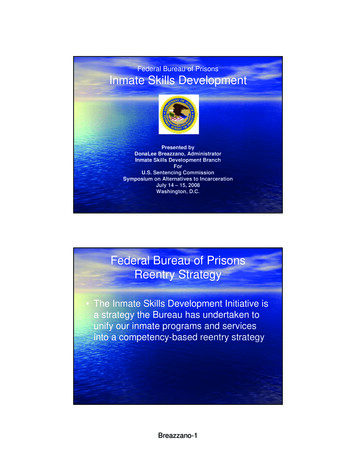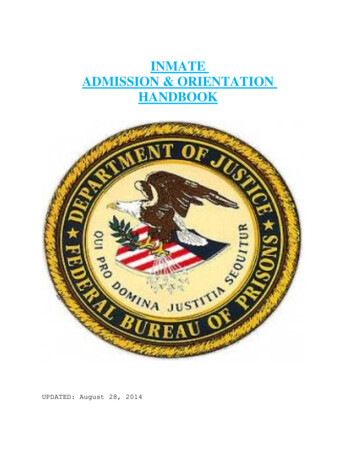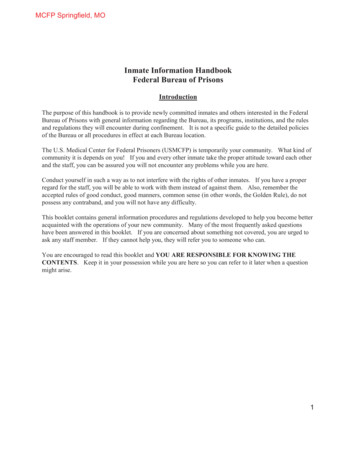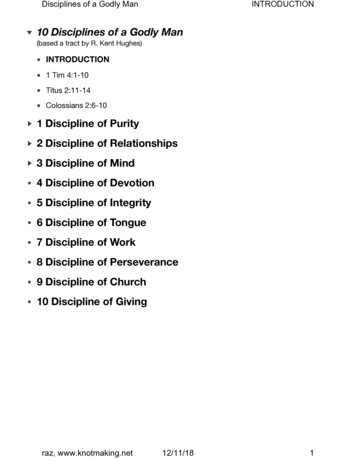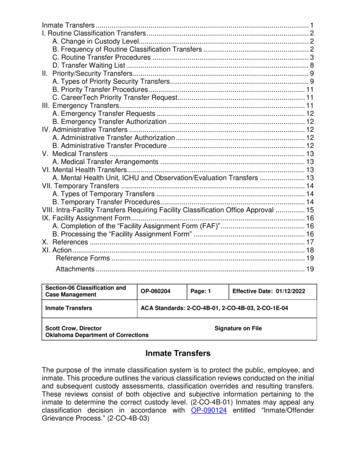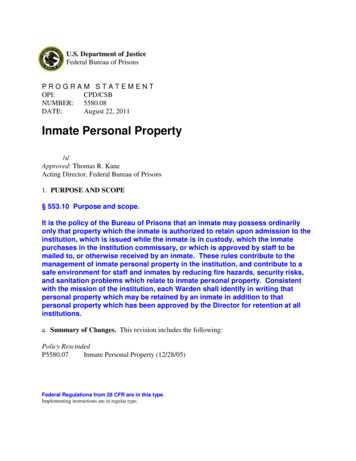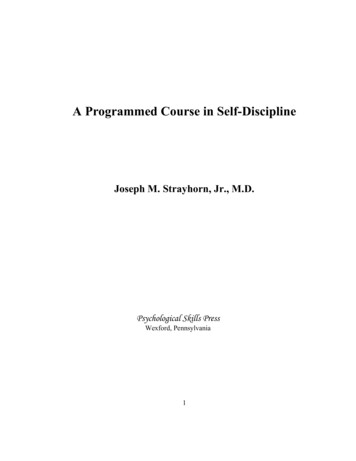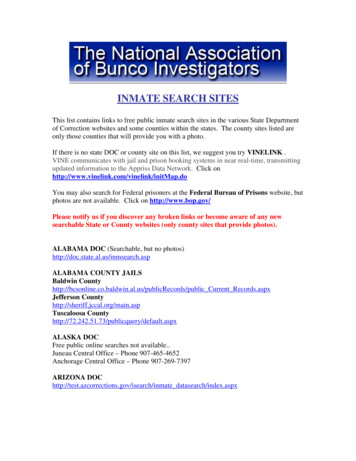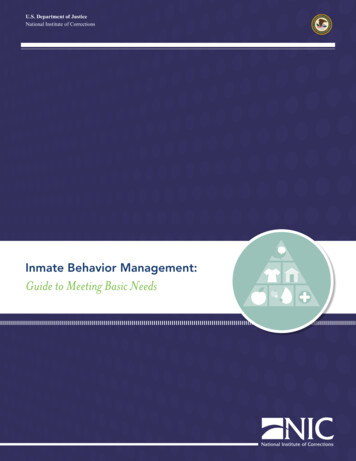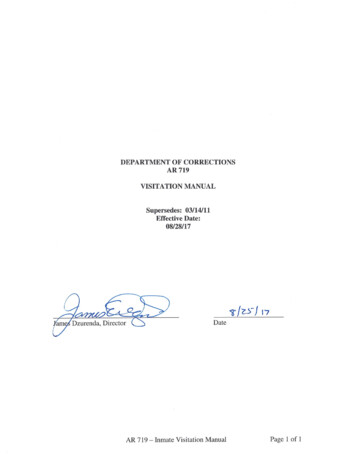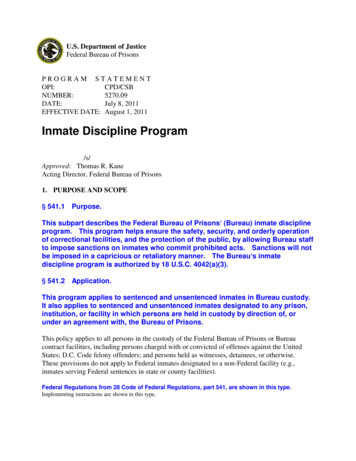
Transcription
U.S. Department of JusticeFederal Bureau of PrisonsPROGRAM STATEMENTOPI:CPD/CSBNUMBER:5270.09DATE:July 8, 2011EFFECTIVE DATE: August 1, 2011Inmate Discipline Program/s/Approved: Thomas R. KaneActing Director, Federal Bureau of Prisons1. PURPOSE AND SCOPE541.1 Purpose.This subpart describes the Federal Bureau of Prisons (Bureau) inmate disciplineprogram. This program helps ensure the safety, security, and orderly operationof correctional facilities, and the protection of the public, by allowing Bureau staffto impose sanctions on inmates who commit prohibited acts. Sanctions will notbe imposed in a capricious or retaliatory manner. The Bureau s inmatediscipline program is authorized by 18 U.S.C. 4042(a)(3).541.2 Application.This program applies to sentenced and unsentenced inmates in Bureau custody.It also applies to sentenced and unsentenced inmates designated to any prison,institution, or facility in which persons are held in custody by direction of, orunder an agreement with, the Bureau of Prisons.This policy applies to all persons in the custody of the Federal Bureau of Prisons or Bureaucontract facilities, including persons charged with or convicted of offenses against the UnitedStates; D.C. Code felony offenders; and persons held as witnesses, detainees, or otherwise.These provisions do not apply to Federal inmates designated to a non-Federal facility (e.g.,inmates serving Federal sentences in state or county facilities).Federal Regulations from 28 Code of Federal Regulations, part 541, are shown in this type.Implementing instructions are shown in this type.
2. SUMMARY OF CHANGESa. Establish Greatest and High severity level prohibited acts for sexual assault of any person.The Greatest severity level act (114) requires the use or threat of force. The High severity levelact (229) is for incidents without the use or threat of force.b. Increase the severity level of escapes from non-secure facilities from a High to a Greatestseverity level prohibited act.c. Amend the Code 104 to include any instrument used as a weapon.d. Establish a Code 115 for destroying and/or disposing of any item during a search or attemptto search.e. Establish a High severity level prohibited act code for escape from a work detail, anon-secure institution, or other non-secure custody, including a community facility, withsubsequent voluntary return to custody within four hours.f. Clarify possession of a cellular telephone or other electronic communications device is aGreatest severity level prohibited act.g. Increase the severity level of all alcohol-related offenses from a High to a Greatest severitylevel prohibited act.h. Establish a High severity level prohibited act code for stalking.i. Establish a High severity level prohibited act code for possession of stolen property.j. Establish a Moderate severity level prohibited act code for circulating a petition.k. Establish a High severity level prohibited act code for refusing to participate in a requiredphysical test or examination unrelated to testing for drug abuse (e.g., DNA, HIV, TB).l. Increase the severity level for tattooing and self-mutilation to a High severity level prohibitedact.m. Establish a Moderate severity level prohibited act code for the fraudulent or deceptivecompletion of a skills test.n. Increase the severity level for conducting a business to a Moderate severity level prohibitedact.o. Establish a Moderate severity level prohibited act code for communicating gang affiliation.P5270.097/8/2011Federal Regulations are shown in this type.Implementing instructions: this type.2
p. Establish Greatest, High, and Moderate severity level prohibited acts for abuse of the mail.q. Establish a sanction of monetary fine.r. Remove the formal sanctions of reprimand and warning.s. Increase the sanction of disciplinary segregation from a range of 7 to 60 days to a range of 1to 18 months.t. Change from three work days to five work days for the UDC to ordinarily conduct a review.u. The Special Housing Unit policy (conditions of disciplinary segregation, administrativedetention, and protection cases) has been removed and guidance is provided in a separateprogram statement.3. PRINCIPLESSeveral general principles apply to every disciplinary action:a. Incident reports can be written by Bureau staff, Federal Prison Industries (FPI) staff, andPublic Health Service (PHS) officers detailed to the Bureau. Community Corrections Managersmay take disciplinary action on inmates in contract RRC s.b. Staff take disciplinary action at such times and to the degree necessary to regulate aninmate’s behavior within Bureau rules and institution guidelines and to promote a safe andorderly institution environment.c. Staff control inmate behavior in an impartial and consistent manner.d. Disciplinary action may not be capricious or retaliatory.e. Staff may not impose or allow corporal punishment of any kind.4. DIRECTIVES AFFECTEDa. Directive RescindedP5270.08Inmate Discipline and Special Housing Units (12/4/09)b. Directives ReferencedP1315.07P1330.16P5270.09Inmate Legal Activities (11/5/99)Administrative Remedy Program (12/31/07)7/8/2011Federal Regulations are shown in this type.Implementing instructions: this type.3
P5884.03P7300.09P7331.04Language Translations Used in Official Documents (10/31/97)Accounting Management Manual (10/15/86)Trust Fund/Deposit Fund Manual (4/19/10)Food Service Manual (6/12/06)Inmate Security Designation and Custody Classification (9/12/06)Categorization of Offenses (3/16/09)Central Inmate Monitoring System (PS Only) (12/31/07)Central Inmate Monitoring System (Operations Manual Only) (3/24/08)Control Unit Programs (2/20/01)Youth Corrections Act (YCA) Inmates and Programs (3/17/99)Inmate Telephone Regulations (1/24/08)Correspondence (4/5/11)Visiting Regulations (5/11/06)Special Housing Units (8/1/11)Inmate Classification and Program Review (11/29/06)Religious Beliefs and Practices (12/31/04)Financial Responsibility Program, Inmate (8/15/05)Correctional Services Manual (10/10/03)Correctional Services Procedures Manual (10/10/03)Searches of Housing Units, Inmates, and Inmate Work Areas (6/30/97)Inmate Personal Property (12/28/05)Correctional Systems Manual (1/1/09)Sentence Computation Manual (CCCA of 1984) (7/20/99)Sentence Computation Manual (Old Law, Pre-CCCA of 1984) (9/8/99)Sentence Computation Manual (District of Columbia) (1/23/01)Good Conduct Time Under the Prison Litigation Reform Act (3/31/06)Community Corrections Manual (5/19/99)Pretrial Inmates (1/31/03)c. Rules cited in this Program Statement are contained in 28 CFR541.2 and541.10-23.5. AGENCY ACA ACCREDITATION PROVISIONSa. American Correctional Association 4th Edition Standards for Adult Correctional Institutions:4-4226, 4-4227, 4-4228, 4-4229, 4-4230, 4-4231, 4-4232, 4-4233, 4-4234, 4-4235, 4-4236,4-4237, 4-4238, 4-4239, 4-4240, 4-4241, 4-4242, 4-4243, 4-4244, 4-4245, 4-4246, 4-4247,4-4248, 4-4255, 4-4399b. American Correctional Association 4th Edition Performance-Based Standards for AdultLocal Detention Facilities:4-ALDF-2A-47, 4-ALDF-2A-50, 4-ALDF-3A-01, 4-ALDF-3A-02, 4-ALDF-4C-40,4-ALDF-6C-01, 4-ALDF-6C-02, 4-ALDF-6C-03, 4-ALDF-6C-04, 4-ALDF-6C-05,P5270.097/8/2011Federal Regulations are shown in this type.Implementing instructions: this type.4
4-ALDF-6C-06, 4-ALDF-6C-07, 4-ALDF-6C-08, 4-ALDF-6C-09, 4-ALDF-6C-10,4-ALDF-6C-11, 4-ALDF-6C-12, 4-ALDF-6C-13, 4-ALDF-6C-14, 4-ALDF-6C-15,4-ALDF-6C-16, 4-ALDF-6C-17, and 4-ALDF-6C-18.6. INSTITUTION SUPPLEMENTSNone required.7. NOTICE TO INMATE OF THE INMATE DISCIPLINE PROGRAMStaff must give each inmate a copy of the following documents promptly after his/her arrival atan institution:Summary of the Inmate Discipline System (Appendix B).Inmate Rights and Responsibilities (Appendix C).Prohibited Acts and Available Sanctions (Table 1).Receipt of these documents must be noted on the intake screening form and maintained in theinmate’s central file. The receipt is kept in the inmate’s central file.To the extent reasonably available, a qualified staff member or translator will help an inmate whohas a language or literacy problem, in accordance with the Program Statement LanguageTranslations Used in Official Documents.P5270.097/8/2011Federal Regulations are shown in this type.Implementing instructions: this type.5
CONTENTSChapter 1541.3 Prohibited acts and available sanctions.9(a) Prohibited acts .9(b) Available sanctions .9(1) Greatest Severity Level Offenses .9(2) High Severity Level Offenses .9(3) Moderate Severity Level Offenses .9(4) Low Severity Level Offenses .10(5) All Severity Level Offenses .10541.4 Loss of good conduct sentence credit as a mandatory sanction .11(a) Groups that lose good conduct sentence credit .11(1) VCCLEA – violent inmates .11(2) PLRA inmates and D.C. Code offenders .11(b) Amount of credit lost .11(1) Greatest Severity Level Offenses .11(2) High Severity Level Offenses .11(3) Moderate Severity Level Offenses .12(4) Low Severity Level Offenses .12Available Sanctions .12(A) Recommend Parole Date Rescission or Retardation .12(B) Forfeit Earned Statutory Good Time, Non-vested Good Conduct Time,or Terminate or Disallow Extra Good Time .12(B.1) Disallowance of Good Conduct Time .13(C) Disciplinary Segregation .14(D) Make Monetary Restitution .15(E) Monetary Fine .15(F) Loss of Privileges .15(G) Change Housing Quarters .15(H) Remove from Program or Group Activity .15(I) Loss of Job .16(J) Impound Inmate’s Personal Property .16(K) Confiscate Contraband .16(L) Restrict to Quarters .16(M) Extra Duty.16P5270.097/8/2011Federal Regulations are shown in this type.Implementing instructions: this type.6
Chapter 2541.5 Discipline process .17(a) Incident report .17(b) Investigation .18(1) Information .18(2) Statement .18(3) Informally resolving the incident report .20Chapter 3541.6 Mentally ill inmates .21(a) Competency to participate in disciplinary proceedings .21(b) Responsibility for conduct .21Chapter 4541.7 Unit Discipline Committee (UDC) review of the incident report .23(a) Available dispositions .23(b) UDC members.23(c) Timing .24(d) Inmate appearance .24(e) Evidence .24(f) Sanctions .24(g) Referral to the DHO .25(h) Written report .25(i) Appeals .25Chapter 5541.8 Discipline Hearing Officer (DHO) hearing .27(a) Available dispositions .27(b) Discipline Hearing Officer .27(c) Timing .27(d) Staff representative.27(1) How to get a staff representative .28(2) How the staff representative will help .28(3) How the staff representative may appear .28(e) Inmate appearance .28(f) Evidence and witnesses .29(g) Sanctions .33(h) Written report .34(i) Appeals .35P5270.097/8/2011Federal Regulations are shown in this type.Implementing instructions: this type.7
APPENDIXESA. List of Forms .37B. Summary of Inmate Discipline System.38C. Inmate Rights and Responsibilities .39D. Data Entry Instructions .41TABLES1. Prohibited Acts and Available Sanctions .442. Additional Available Sanctions for Repeated Prohibited ActsWithin the Same Severity Level .55P5270.097/8/2011Federal Regulations are shown in this type.Implementing instructions: this type.8
CHAPTER 1.541.3 Prohibited acts and available sanctions.(a) Prohibited acts. The list of prohibited acts are divided into four separatecategories based on severity: Greatest; High; Moderate; and Low. We describethe prohibited acts in Table 1 - Prohibited Acts and Available Sanctions. Aiding,attempting, abetting, or making plans to commit any of the prohibited acts istreated the same as committing the act itself.(b) Available sanctions. The list of available sanctions for committingprohibited acts is listed in Table 1 - Prohibited Acts and Available Sanctions. Ifyou commit repetitive prohibited acts, we can impose increased sanctions, aslisted in Table 2 - Additional Available Sanctions for Repeated Prohibited ActsWithin the Same Severity Level.(1) Greatest Severity Level Offenses. The Discipline Hearing Officer (DHO) imposes one ormore of sanctions A through E. Sanction B.1 must be imposed for a VCCLEA inmate rated“violent” (an inmate who, per the Violent Crime Control and Law Enforcement Act of 1994,committed a crime of violence on or after September 13, 1994) and for a PLRA inmate (aninmate sentenced for an offense committed on or after April 26, 1996, per the Prison LitigationReform Act). The DHO may impose any available sanctions (A through M) in addition tosanctions A through E. All Greatest severity level charges must be referred to the DHO.(2) High Severity Level Offenses. The DHO imposes one or more of sanctions A through M,and, except as noted in the sanction, may also suspend one or more sanctions A through M.Sanction B.1 must be imposed for a VCCLEA inmate rated “violent” and for a PLRA inmate.All High severity level charges must be referred to the DHO.Prohibited Act Code 225, Stalking, is for the purpose of punishing repetitive inmate behavior,e.g., loitering, staring, leering, inappropriate remarks (short of insolence, profanity, or sexualproposals), that are not clearly covered by another prohibited act code. When staff encountersuch behavior, the inmate should be specifically warned that it is inappropriate and must cease.If the behavior fits another prohibited act code provision, the inmate should be charged withviolating that specific provision instead of stalking. Examples of other prohibited act codebehavior that may be used instead of Code 225, Stalking, include, but are not limited to Insolence(Code 312), Being in an Unauthorized Area (Code 316), Threatening (Code 203), and Making aSexual Proposal or Threat (Code 206).(3) Moderate Severity Level Offenses. The DHO imposes at least one sanction A through M,but, except as noted in the sanction, may suspend any sanction(s) imposed. Sanction B.1ordinarily must be imposed for a VCCLEA inmate rated “violent” and for a PLRA inmate.P5270.097/8/2011Federal Regulations are shown in this type.Implementing instructions: this type.9
Except for charges referred to the DHO, the Unit Discipline Committee (UDC) shall impose atleast one sanction F through M, but may suspend any sanctions imposed.The UDC ordinarily refers to the DHO a moderate severity level charge for a VCCLEA inmaterated “violent” or for a PLRA inmate if the inmate was found to have committed two moderateoffenses during his/her current anniversary year (the 12-month period for which an inmate maybe eligible to earn good conduct time [GCT]). The UDC must document the reasons why a thirdcharge for such an inmate was not referred to the DHO.A prohibited act charge for 331 involving tobacco or nutritional supplements must be referred tothe DHO for final disposition.(4) Low Severity Level Offenses. The DHO imposes at least one sanction B.1, or D throughM. The DHO may suspend any sanction(s) imposed; however, a B.1 sanction may not besuspended. Except for charges referred to the DHO, the UDC imposes at least one sanction Fthrough M, but may suspend any sanction(s) imposed.The UDC ordinarily refers to the DHO a low severity level charge for a VCCLEA inmate rated“violent” or for a PLRA inmate if the inmate had been found to have committed three lowoffenses during his/her current anniversary year. The UDC must document the reasons why acharge for such an inmate was not referred to the DHO.Sanction B.1 may be imposed on the Low severity level only if the inmate has committed a Lowseverity level prohibited act more than once within a six-month period (except for a VCCLEAinmate rated “violent” or a PLRA inmate).(5) All Severity Level Offenses. In all categories of severity, aiding another person tocommit any of these offenses, attempting to commit them, or making plans to commit them, isconsidered equivalent to committing the offense itself. In these cases, the letter “A” iscombined with the offense code. For example, planning an escape is Escape, Code 102A.Attempting to adulterate food or drink is Code 209A.When the prohibited act is Interfering with a Staff Member in the Performance of Duties(Code 198, 298, 398 or 498) or Conduct Which Disrupts (Code 199, 299, 399, or 499), theDHO or UDC must specify the severity level of the conduct that is most comparable to anoffense(s) at that severity level. Example: “I find the act of Conduct Which Disrupts (Code299) to be of High severity level, most comparable to the prohibited act of Engaging in a GroupDemonstration (Code 212).”Suspensions of any sanction cannot exceed six months. Suspended sanctions may only berevoked and executed if the inmate is found to have committed a subsequent prohibited act.Only the DHO may execute, suspend, or revoke and execute suspension of sanctions A through E(B and B.1. may never be suspended). The DHO or UDC may execute, suspend, or revoke andP5270.097/8/2011Federal Regulations are shown in this type.Implementing instructions: this type.10
execute suspensions of sanctions F through M. The DHO may execute UDC-suspendedsanctions. However, the UDC may not execute DHO-suspended sanctions A through E.When an inmate receives an incident report while on a DHO-imposed, but suspended sanction,the new incident report is forwarded by the UDC to the DHO, both for a final disposition on thenew incident report, and for a disposition on the suspended sanction. This procedure is notnecessary when the UDC informally resolves the new incident report. The DHO may return anincident report to the UDC if a decision not to execute the suspended sanction is made.The UDC or DHO may impose increased sanctions for repeated, frequent offenses per theguidelines in Table 2.Noting that not all UDC or DHO decisions finding an inmate committed a prohibited act willresult in a change to the inmate s security designation score, the Unit Team may recommend agreater security transfer, using their professional judgment, and in accordance with the policy onInmate Security Designation and Custody Classification.541.4 Loss of good conduct sentence credit as a mandatory sanction.(a) You will lose good conduct sentence credit as a mandatory disciplinarysanction if you are in one of the following two groups:(1) VCCLEA-violent inmates. The date of your U.S. Code offense was on orafter September 13, 1994, but before April 26, 1996, and you committed a “crimeof violence” as defined by the Violent Crime Control and Law Enforcement Act of1994 (VCCLEA); or(2) PLRA inmates and D.C. Code offenders. The date of your U.S. Code offensewas on or after April 26, 1996, and, therefore, under the Prison Litigation ReformAct (PLRA), or the date of your District of Columbia (DC) Code offense was on orafter August 5, 2000.(b) If you are an inmate in one of the above groups and commit a prohibited act,you will lose good conduct sentence credit as a mandatory disciplinary sanction.The amount of good conduct sentence credit you will lose depends on theseverity level of the prohibited act(s) committed, as follows:(1) Greatest Severity Level Offenses. You will lose at least 41 days, or 75% ofavailable credit if less than 54 days are available for the prorated period, for eachact committed.(2) High Severity Level Offenses. You will lose at least 27 days, or 50% ofavailable credit if less than 54 days are available for the prorated period, for eachact committed.P5270.097/8/2011Federal Regulations are shown in this type.Implementing instructions: this type.11
(3) Moderate Severity Level Offenses. You will lose at least 14 days, or 25% ofavailable credit if less than 54 days are available for the prorated period, aftercommitting two or more Moderate severity acts during the current year of yourgood conduct sentence credit availability.(4) Low Severity Level Offenses. You will lose at least 7 days, or 12.5% ofavailable credit if less than 54 days are available for the prorated period, aftercommitting three or more Low severity acts during the current year of your goodconduct sentence credit availability.Available Sanctions (upon finding the inmate committed the prohibited act(s)):(A) Recommend Parole Date Rescission or Retardation. The DHO may recommendretardation or rescission of parole grants to the U.S. Parole Commission or respective paroleauthority.(B) Forfeit Earned Statutory Good Time, Non-vested Good Conduct Time, or Terminateor Disallow Extra Good Time.Forfeited good conduct time (GCT) is not eligible for restoration. However, forfeited statutorygood time (SGT) may be restored. Restoration of statutory good time is approved at initialeligibility only when the inmate has shown a period of improved good behavior. When theWarden (or designee) denies restoration of forfeited statutory good time, the unit team notifiesthe inmate of the reasons for denial. The unit team establishes a new eligibility date, not toexceed six months from the date of denial.An application for restoration of statutory good time is forwarded from the inmate’s unit team,through the DHO and Captain for comments, to the Warden for final decision.Inmates who committed their crimes on or after November 1, 1987, and are sentenced under theSentencing Reform Act provisions of the Comprehensive Crime Control Act, are only eligible toreceive 54 days GCT credit (18 U.S.C. 3624(b)). This credit is given at the end of each yearserved and, once given, is vested. For these inmates, the DHO’s authority is final and subjectonly to review by the Regional Director to ensure conformity with the discipline policy and byinmate appeal through Administrative Remedy procedures.The statutory good time available for forfeiture is limited to an amount computed by multiplyingthe months served at the time of the offense for which forfeiture is taken, by the applicablemonthly rate specified in 18 U.S.C. 4161 (less previous forfeiture or withholding). Theamount of GCT available for forfeiture is limited to total days in “non-vested” status at the timeof misconduct (less previous forfeiture).Forfeiture of GCT may not be suspended.P5270.097/8/2011Federal Regulations are shown in this type.Implementing instructions: this type.12
Disallowance of extra good time is limited to extra good time for the calendar month in whichthe violation occurs. It may not be withheld or restored.The sanction of termination or disallowance of extra good time may not be suspended.Forfeited GCT will not be restored. Authority to restore forfeited statutory good time isdelegated to the Warden, and may not be delegated lower than the Associate Warden level.Limitations on this sanction and eligibility for restoration are based on the severity scale. (SeeTable 2.)To ensure an inmate’s case is not overlooked when statutory good time has been forfeited, theunit manager will ensure the eligibility requirements are reviewed for restoration per the timeframes in the Program Statement on Classification and Program Review of Inmates. Arecommendation of the unit team for or against restoration is forwarded to the Warden throughthe DHO and Captain. Except as noted, eligibility for restoration of forfeited statutory goodtime is computed from the date of the withholding or forfeiture action by the DHO.An inmate who has escaped and receives a forfeiture at a subsequent in absentia hearing beginsthe eligibility for restoration period upon return to Bureau custody. The Warden refers to theRegional Director any case where exceptional circumstances support restoration of statutorygood time before completion of the eligibility requirements.Sanction B does not apply to inmates committed under the Comprehensive Crime Control Actfor crimes committed on or after November 1, 1987, and prior to passage of the Violent CrimeControl and Law Enforcement Act of 1994 (September 23, 1994). For those inmates, theapplicable sanction is B.1.(B.1) Disallowance of Good Conduct Time. An inmate sentenced under the SentencingReform Act provisions of the Comprehensive Crime Control Act (committed a crime on or afterNovember 1, 1987) may not receive statutory good time, but is eligible to receive 54 days GCTcredit each y
of correctional facilities, and the protection of the public, by allowing Bureau staff to impose sanctions on inmates who commit prohibited acts. Sanctions will not be imposed in a capricious or retaliatory manner. The Bureau s inmate discipline program is authorized by 18 U.S.C. 4042(a)(3). 541.2 Application.
